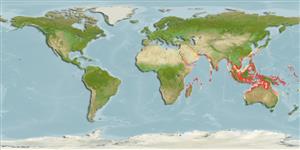Environment: milieu / climate zone / depth range / distribution range
นิเวศวิทยา
เกี่ยวกับทะเล,น้ำเค็ม; น้ำจืด; กร่อย สัตว์น้ำหน้าดิน; สัตว์น้ำที่อพยพไปๆมาๆ ระหว่างแหล่งน้ำจืดกับทะเล ที่เป็นไปตามช่วงชีวิต (Ref. 51243). Tropical; 27°N - 19°S, 72°E - 177°W
Indo-West Pacific: west and south coasts of India and off Sri Lanka eastward along the coasts of Bangladesh and Myanmar, through the Indo-Australian Archipelago and the Philippines as far as Papua New Guinea.
ขนาด / น้ำหนัก / Age
Maturity: Lm ? range ? - ? cm
Max length : 111 cm TL เพศผู้/กระเทย; (Ref. 127983); common length : 80.0 cm TL เพศผู้/กระเทย; (Ref. 3478)
A plain dusky-brown species with a black dorsal fin tip. Shows banded pattern at night. Distinguished from adult Plotosus lineatus by its long barbels on the nostrils that can reach pass the eyes.
Adults found mostly in estuaries and lagoons, and sometimes up rivers in nearly fresh waters. They occur in the lower parts of rivers in freshwater or brackish water and in coastal seas (Ref. 12693, 48635). It is reported to have an extended breeding season and likely spawns in brackish water, based on optimal sperm survival at 0.9 % salinity; produces relatively few large eggs, consistent with parental care and it is possible that male fish construct nests and guard their fry (Ref. 127983), Maximum length of 150 cm TL is without actual specimen (Ref. 3478). Juveniles may occur in dense aggregations (Ref. 9801). Feed on crustaceans, mollusks and fishes. Spines associated with anterior fins have potent venom. Marketed mostly fresh.
Life cycle and mating behavior
วัยเจริญพันธุ์ | การสืบพันธุ์ | การวางไข่ | เซลสืบพันธ์ของเพศเมีย(ไข่) | ความดกของไข่ | ตัวอ่อน
Gomon, J.R., 1984. Plotosidae. In W. Fischer and G. Bianchi (eds.) FAO species identification sheets for fishery purposes. Western Indian Ocean fishing area 51. Vol. 3. (Ref. 3478)
IUCN Red List Status (Ref. 130435)
Human uses
การประมง: การค้า
ข้อมูลเพิ่มเติม
ชื่อสามัญชื่อพ้องกลไกการเผาผลาญพลังงานผู้ล่าการศึกษาเกี่ยวกับผลกระทบของสารประกอบทางเคมีที่เป็นอันตรายต่อสิ่งมีชีวิต ประชากร และสิ่งแวดล้อมการสืบพันธุ์วัยเจริญพันธุ์การวางไข่การรวมกลุ่มวางไข่ความดกของไข่เซลสืบพันธ์ของเพศเมีย(ไข่)Egg development
อ้างอิงการเพาะเลี้ยงสัตว์น้ำประวัติการเพาะเลี้ยงสัตว์น้ำสายพันธุ์พันธุศาสตร์ElectrophoresesอัตราพันธุกรรมโรคการแปรรูปNutrientsMass conversion
ผู้ร่วมมือรูปภาพหลายรูปStamps, Coins Misc.เสียงปลามีพิษ เช่น ปลาปักเป้าความเร็วรูปแบบการว่ายน้ำพื้นที่เหงือกOtolithsสมองวิสัยทัศน์
เครื่องมือ
Special reports
Download XML
แหล่งที่มาจากอินเตอร์เน็ต
Estimates based on models
Preferred temperature (Ref.
123201): 25.1 - 29.1, mean 28.3 °C (based on 1244 cells).
Phylogenetic diversity index (Ref.
82804): PD
50 = 0.5020 [Uniqueness, from 0.5 = low to 2.0 = high].
Bayesian length-weight: a=0.00490 (0.00248 - 0.00968), b=3.02 (2.84 - 3.20), in cm total length, based on LWR estimates for this species & (Sub)family-body (Ref.
93245).
ระดับชั้นอาหาร (Ref.
69278): 3.8 ±0.4 se; based on diet studies.
Generation time: 3.9 ( na - na) years. Estimated as median ln(3)/K based on 1
growth studies.
ความสามารถในการกลับคืนสู่ปกติ (Ref.
120179): ขนาดกลาง, เวลาต่ำสุดที่จะทำให้ประชากรเพิ่มขึ้นเป็น 2 เท่าใช้เวลา 1.4 - 4.4 ปี (Preliminary K or Fecundity.).
Fishing Vulnerability (Ref.
59153): Moderate vulnerability (43 of 100).
Nutrients (Ref.
124155): Calcium = 63.2 [34.5, 108.6] mg/100g; Iron = 0.78 [0.49, 1.27] mg/100g; Protein = 16.9 [14.7, 19.1] %; Omega3 = 0.147 [0.082, 0.262] g/100g; Selenium = 81.8 [43.4, 163.8] μg/100g; VitaminA = 11.2 [5.1, 25.6] μg/100g; Zinc = 0.934 [0.684, 1.292] mg/100g (wet weight);
